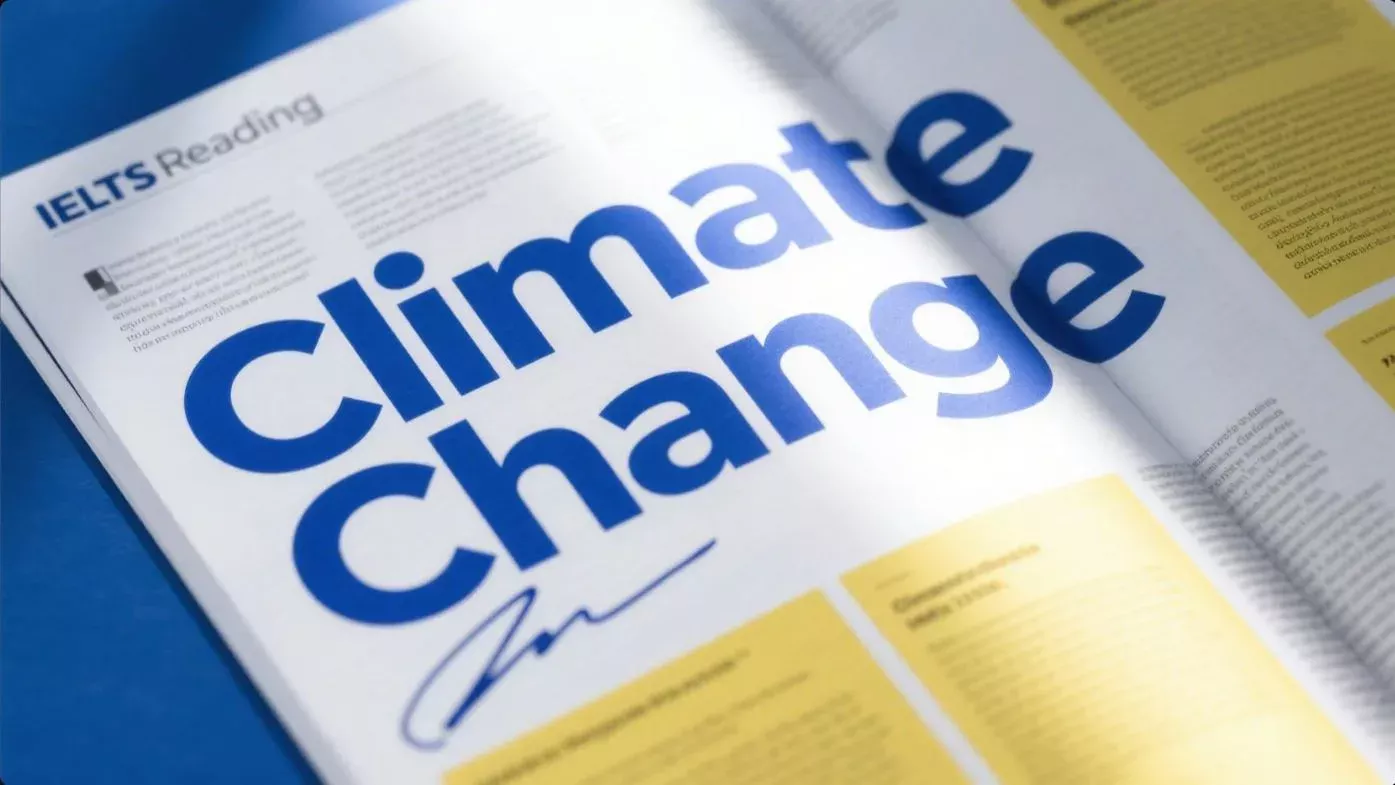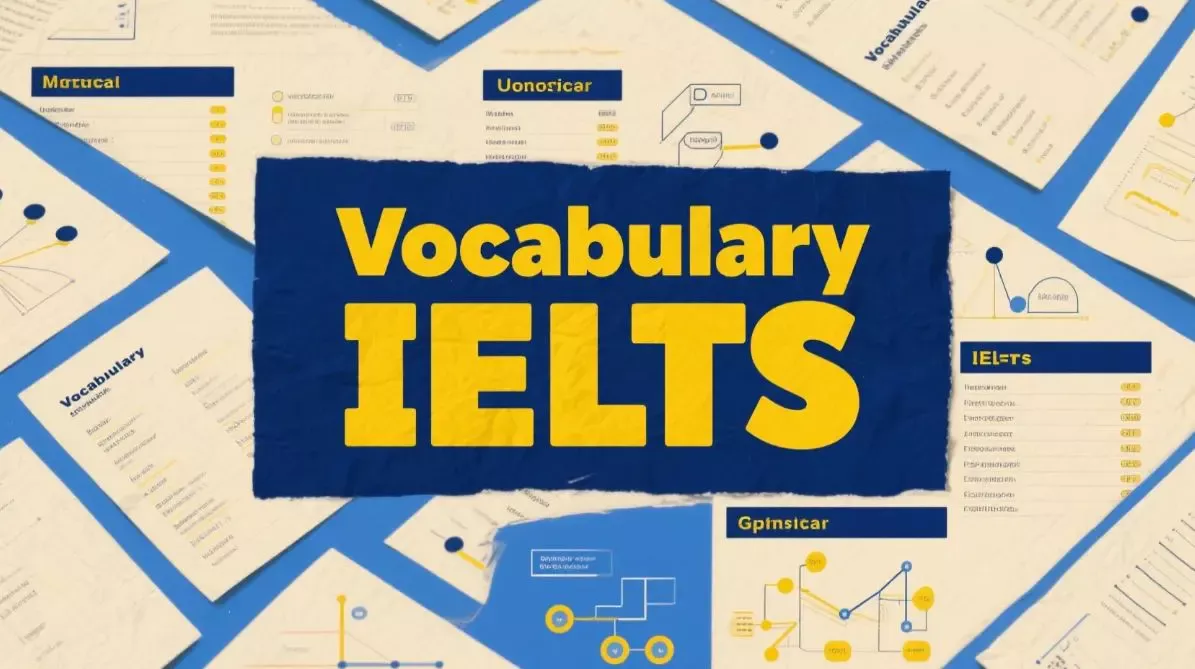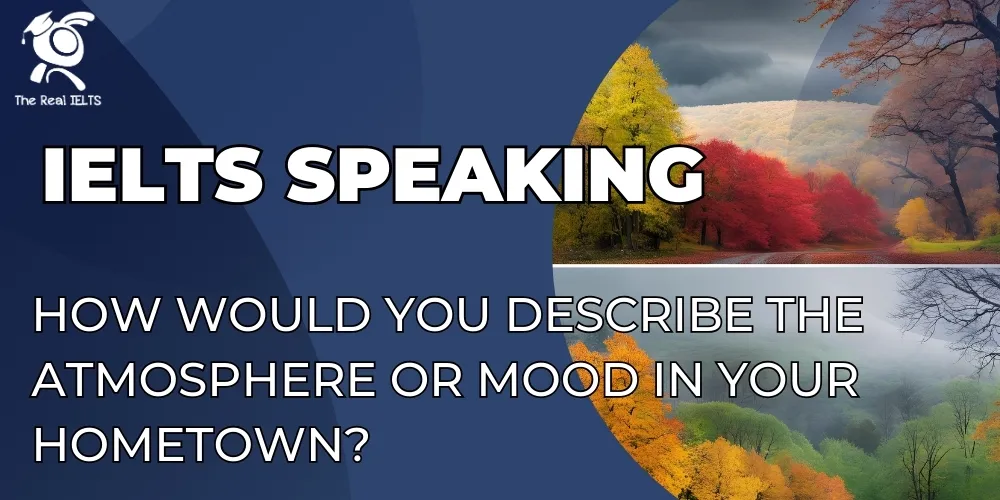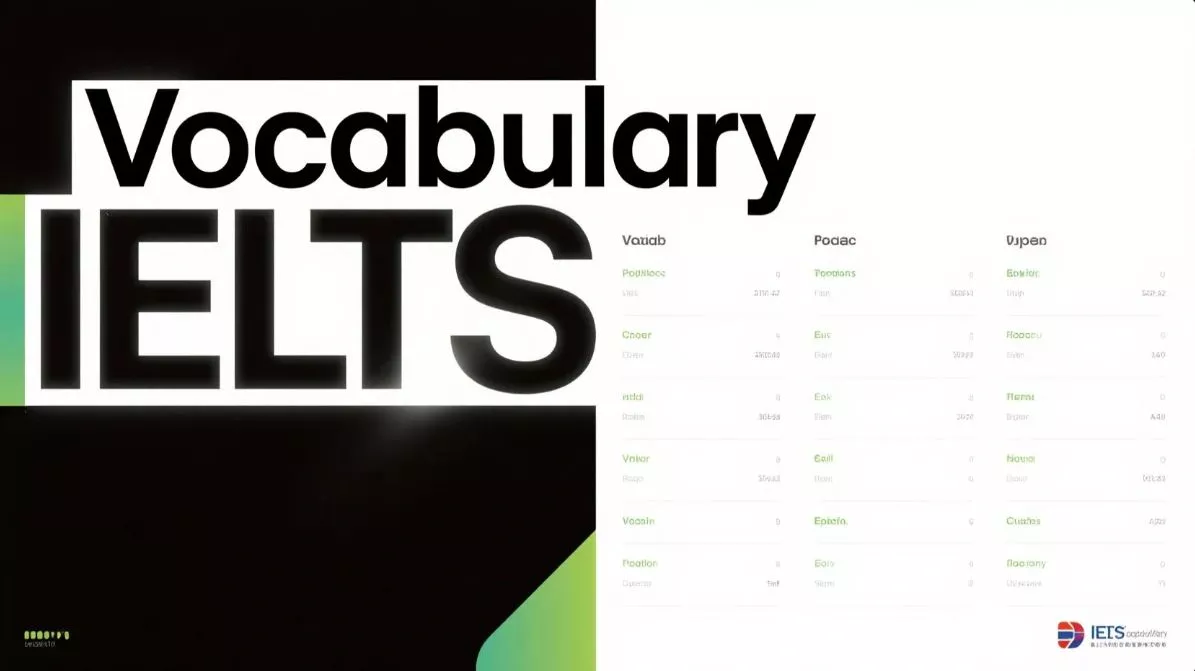Kỹ năng đọc hiểu là một trong những thử thách lớn nhất đối với thí sinh thi IELTS, đòi hỏi khả năng phân tích nhanh và nắm bắt thông tin chính xác từ các văn bản học thuật phức tạp. IELTS Reading không chỉ kiểm tra vốn từ vựng mà còn yêu cầu tư duy logic và quản lý thời gian hiệu quả. Với độ khó tăng dần qua mỗi phần, người học cần chiến lược rõ ràng để đạt band điểm mong muốn, đặc biệt trong bối cảnh cạnh tranh học thuật toàn cầu.
Đọc thêm: IELTS Reading Practice Test: The Impact of Fashion.
IELTS Reading The Impacts of Climate Change
Climate change is reshaping coastal ecosystems worldwide. Rising sea levels, driven by melting polar ice caps and warming oceans, threaten low-lying coastal areas. Scientists estimate that by 2100, sea levels could rise by up to one meter, flooding habitats like mangroves and salt marshes. These ecosystems act as natural barriers, protecting coastlines from erosion and storms. Their loss could lead to severe economic and environmental consequences.
Warmer ocean temperatures also disrupt marine life. Coral reefs, often called the “rainforests of the sea,” are particularly vulnerable. Higher temperatures cause coral bleaching, where corals expel the algae living within them, leading to widespread coral death. This affects fish populations that rely on reefs for food and shelter, disrupting fishing industries.
Coastal communities face increasing risks from extreme weather events, such as hurricanes and typhoons, which are becoming more frequent and intense due to climate change. These events destroy infrastructure and displace populations, especially in developing nations with limited resources to adapt.
Efforts to combat these impacts include restoring mangroves and building seawalls. However, these measures are costly and not always effective. International cooperation is essential to reduce greenhouse gas emissions, the primary driver of climate change. While some progress has been made through agreements like the Paris Accord, challenges remain in enforcing global commitments. Coastal ecosystems continue to face an uncertain future unless urgent action is taken.
(Word count: 248)
Câu hỏi
Questions 1–5: Multiple Choice
- What is the primary cause of rising sea levels mentioned in the passage?
A. Increased rainfall
B. Melting polar ice caps and warming oceans
C. Deforestation
D. Volcanic activity - What role do mangroves and salt marshes play?
A. They increase coastal erosion.
B. They act as natural barriers against storms.
C. They contribute to coral bleaching.
D. They reduce greenhouse gas emissions. - Coral bleaching occurs when:
A. Corals absorb too much sunlight.
B. Corals expel algae due to high temperatures.
C. Fish populations decline.
D. Ocean currents change direction. - What is a consequence of extreme weather events mentioned in the passage?
A. Improved fishing yields
B. Destruction of infrastructure
C. Increased mangrove growth
D. Reduced sea levels - What is a challenge mentioned regarding international efforts to address climate change?
A. Lack of scientific evidence
B. Difficulty enforcing global commitments
C. Absence of international agreements
D. Overfunding of restoration projects
Questions 6–10: True/False/Not Given
- Sea levels are predicted to rise by up to one meter by 2050.
- Coral reefs are unaffected by rising ocean temperatures.
- Mangroves help protect coastlines from erosion.
- Developing nations are less affected by extreme weather events.
- The Paris Accord has fully resolved issues related to greenhouse gas emissions.
Questions 11–15: Yes/No/Not Given
- Are coastal ecosystems important for protecting against storms?
- Does climate change only affect developed countries?
- Are coral reefs essential for fish populations?
- Have all coastal communities adopted seawalls to combat climate change?
- Is international cooperation necessary to address climate change?
Questions 16–20: Matching Information
Match the following statements to the correct paragraph (A–D).
A. Paragraph 1
B. Paragraph 2
C. Paragraph 3
D. Paragraph 4
- Coral reefs are highly sensitive to warmer ocean temperatures.
- Rising sea levels threaten low-lying coastal areas.
- Extreme weather events are becoming more frequent.
- International agreements face enforcement challenges.
- Mangrove restoration is a costly solution.
Questions 21–25: Matching Headings
Choose the correct heading for each paragraph from the list below.
i. Economic Impacts of Climate Change
ii. The Role of Coastal Ecosystems
iii. Challenges in Global Cooperation
iv. Effects on Marine Life
v. Rising Sea Levels and Their Consequences
- Paragraph 1
- Paragraph 2
- Paragraph 3
- Paragraph 4
- (No paragraph – distractor)
Questions 26–30: Matching Sentence Endings
Complete each sentence with the correct ending (A–E).
26. Rising sea levels are caused by…
27. Coral bleaching leads to…
28. Extreme weather events result in…
29. Mangroves and salt marshes…
30. The Paris Accord aims to…
A. reduce greenhouse gas emissions.
B. protect coastlines from erosion and storms.
C. melting ice caps and warming oceans.
D. displacement of coastal populations.
E. the death of corals and reduced fish populations.
Questions 31–35: Sentence Completion
Complete the sentences using no more than three words from the passage.
31. Rising sea levels threaten ________ habitats.
32. Coral bleaching is caused by ________ temperatures.
33. Extreme weather events are becoming more ________.
34. Mangrove restoration is a ________ solution.
35. Greenhouse gas emissions are the ________ driver.
Questions 36–40: Summary Completion
Complete the summary using words from the word bank.
Word Bank: ecosystems, storms, coral bleaching, greenhouse gases, international cooperation
The effects of climate change on coastal areas are severe. Rising sea levels threaten coastal (36) ________, such as mangroves and salt marshes, which protect against (37) ________. Warmer oceans lead to (38) ________, harming marine life. Extreme weather events cause significant damage, particularly in vulnerable regions. Reducing (39) ________ is crucial, and (40) ________ is needed to address these global challenges effectively.
Đáp án và Giải thích
Question 1
- Correct Option: B
- Explanation: Câu hỏi hỏi về nguyên nhân chính của mực nước biển dâng cao. Bài đọc nêu rõ: “Rising sea levels, driven by melting polar ice caps and warming oceans…” (Mực nước biển dâng cao do băng tan ở hai cực và đại dương ấm lên). Đáp án B khớp với thông tin này. Các đáp án khác (mưa nhiều, phá rừng, hoạt động núi lửa) không được đề cập.
Question 2
- Correct Option: B
- Explanation: Bài đọc nói rằng: “These ecosystems act as natural barriers, protecting coastlines from erosion and storms.” (Các hệ sinh thái này đóng vai trò như rào cản tự nhiên, bảo vệ bờ biển khỏi xói mòn và bão). Đáp án B đúng. Các đáp án khác không phù hợp vì chúng mâu thuẫn hoặc không được đề cập.
Question 3
- Correct Option: B
- Explanation: Bài đọc giải thích: “Higher temperatures cause coral bleaching, where corals expel the algae living within them…” (Nhiệt độ cao gây tẩy trắng san hô, khi san hô đẩy tảo ra ngoài). Đáp án B chính xác. Các lựa chọn khác không đúng với thông tin.
Question 4
- Correct Option: B
- Explanation: Bài đọc đề cập: “These events destroy infrastructure and displace populations…” (Các sự kiện thời tiết cực đoan phá hủy cơ sở hạ tầng và khiến dân chúng di dời). Đáp án B phù hợp. Các đáp án khác không được đề cập hoặc sai.
Question 5
- Correct Option: B
- Explanation: Bài đọc nêu: “While some progress has been made through agreements like the Paris Accord, challenges remain in enforcing global commitments.” (Mặc dù có tiến bộ qua các hiệp định như Paris Accord, nhưng vẫn còn thách thức trong việc thực thi cam kết toàn cầu). Đáp án B đúng. Các lựa chọn khác không phù hợp.
Question 6
- Correct Answer: False
- Explanation: Bài đọc nói mực nước biển có thể dâng cao tới một mét vào năm 2100, không phải 2050. Do đó, câu này sai.
Question 7
- Correct Answer: False
- Explanation: Bài đọc nêu rõ rằng rạn san hô bị ảnh hưởng bởi nhiệt độ đại dương tăng, gây tẩy trắng san hô. Câu này sai.
Question 8
- Correct Answer: True
- Explanation: Bài đọc xác nhận: “These ecosystems act as natural barriers, protecting coastlines from erosion and storms.” Câu này đúng.
Question 9
- Correct Answer: False
- Explanation: Bài đọc nói các quốc gia đang phát triển dễ bị ảnh hưởng hơn bởi các sự kiện thời tiết cực đoan do thiếu nguồn lực. Câu này sai.
Question 10
- Correct Answer: False
- Explanation: Bài đọc cho biết Paris Accord có tiến bộ nhưng vẫn còn thách thức, nghĩa là vấn đề khí thải nhà kính chưa được giải quyết hoàn toàn. Câu này sai.
Question 11
- Correct Answer: Yes
- Explanation: Bài đọc xác nhận hệ sinh thái ven biển bảo vệ bờ biển khỏi bão.
Question 12
- Correct Answer: No
- Explanation: Bài đọc đề cập rằng các quốc gia đang phát triển đặc biệt dễ bị ảnh hưởng, chứng tỏ biến đổi khí hậu không chỉ ảnh hưởng đến các nước phát triển.
Question 13
- Correct Answer: Yes
- Explanation: Bài đọc nói rằng rạn san hô là nguồn thức ăn và nơi trú ẩn cho cá, nghĩa là chúng rất quan trọng.
Question 14
- Correct Answer: Not Given
- Explanation: Bài đọc đề cập đến việc xây dựng tường biển nhưng không nói rằng tất cả các cộng đồng ven biển đều áp dụng biện pháp này.
Question 15
- Correct Answer: Yes
- Explanation: Bài đọc nhấn mạnh sự cần thiết của hợp tác quốc tế để giảm khí thải nhà kính.
Question 16
- Correct Answer: B
- Explanation: Đoạn 2 nói về tác động của nhiệt độ đại dương đến rạn san hô.
Question 17
- Correct Answer: A
- Explanation: Đoạn 1 đề cập đến mực nước biển dâng cao đe dọa các khu vực ven biển thấp.
Question 18
- Correct Answer: C
- Explanation: Đoạn 3 nói về các sự kiện thời tiết cực đoan ngày càng thường xuyên.
Question 19
- Correct Answer: D
- Explanation: Đoạn 4 đề cập đến thách thức trong việc thực thi các cam kết toàn cầu.
Question 20
- Correct Answer: D
- Explanation: Đoạn 4 nói rằng phục hồi rừng ngập mặn là một giải pháp tốn kém.
Question 21
- Correct Answer: v
- Explanation: Đoạn 1 tập trung vào mực nước biển dâng cao và hậu quả.
Question 22
- Correct Answer: iv
- Explanation: Đoạn 2 nói về tác động đến sinh vật biển, đặc biệt là rạn san hô.
Question 23
- Correct Answer: i
- Explanation: Đoạn 3 đề cập đến thiệt hại kinh tế do thời tiết cực đoan.
Question 24
- Correct Answer: iii
- Explanation: Đoạn 4 nói về thách thức trong hợp tác toàn cầu.
Question 25
- Correct Answer: (No paragraph – distractor)
- Explanation: Đây là lựa chọn thừa, không có đoạn văn tương ứng.
Question 26
- Correct Answer: C
- Explanation: Mực nước biển dâng cao do băng tan và đại dương ấm lên (đoạn 1).
Question 27
- Correct Answer: E
- Explanation: Tẩy trắng san hô dẫn đến cái chết của san hô và giảm quần thể cá (đoạn 2).
Question 28
- Correct Answer: D
- Explanation: Thời tiết cực đoan gây di dời dân chúng (đoạn 3).
Question 29
- Correct Answer: B
- Explanation: Rừng ngập mặn và đầm lầy muối bảo vệ bờ biển (đoạn 1).
Question 30
- Correct Answer: A
- Explanation: Paris Accord nhằm giảm khí thải nhà kính (đoạn 4).
Question 31
- Correct Answer: low-lying
- Explanation: Bài đọc: “threaten low-lying coastal areas.”
Question 32
- Correct Answer: higher
- Explanation: Bài đọc: “Higher temperatures cause coral bleaching.”
Question 33
- Correct Answer: frequent, intense
- Explanation: Bài đọc: “hurricanes and typhoons, which are becoming more frequent and intense.”
Question 34
- Correct Answer: costly
- Explanation: Bài đọc: “these measures are costly.”
Question 35
- Correct Answer: primary
- Explanation: Bài đọc: “greenhouse gas emissions, the primary driver.”
Question 36
- Correct Answer: ecosystems
- Explanation: Hệ sinh thái ven biển như rừng ngập mặn và đầm lầy muối được đề cập trong đoạn 1.
Question 37
- Correct Answer: storms
- Explanation: Rừng ngập mặn và đầm lầy muối bảo vệ bờ biển khỏi bão (đoạn 1).
Question 38
- Correct Answer: coral bleaching
- Explanation: Nhiệt độ đại dương ấm hơn gây tẩy trắng san hô (đoạn 2).
Question 39
- Correct Answer: greenhouse gases
- Explanation: Giảm khí thải nhà kính là cần thiết (đoạn 4).
Question 40
Explanation: Hợp tác quốc tế được nhấn mạnh trong đoạn 4.
Correct Answer: international cooperation















